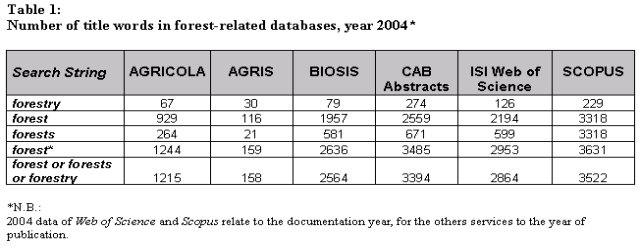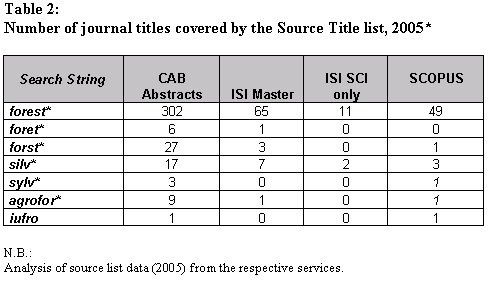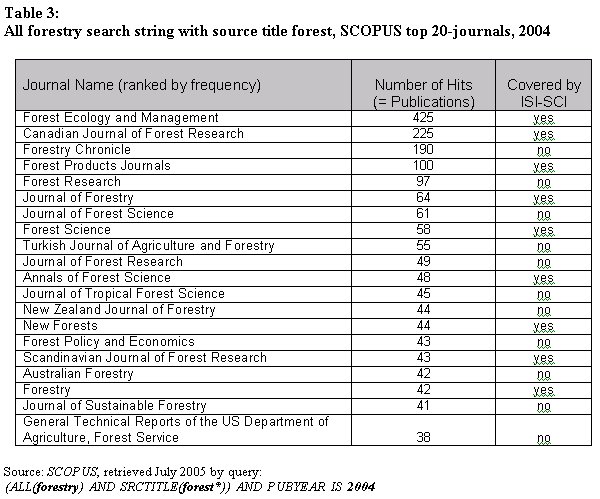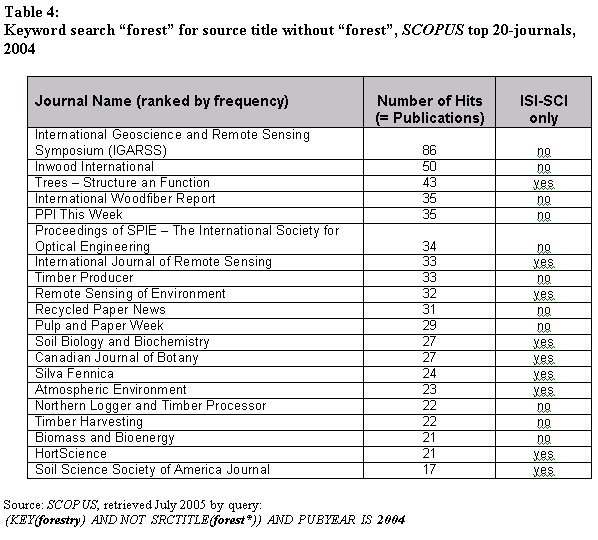Context Links and Forest-Related Coverage of Information Services
WSL, Swiss Federal Institute for Forest, Snow and Landscape Research
CH-8903 Birmensdorf
alois.kempf@wsl.ch
Abstract
The web has become the favourite user interface for accessing and exchanging scientific information. Within this hypertext framework new applications are made possible, e.g., forward linking to aggregated information resources or cited reference searching. Paralleling the technical developments, one can observe the convergence of primary and secondary literature services. More and more scholarly journals, university theses and research reports are available in full-text. However, what the user can access in a specific situation will heavily depend on the subscriptions held by the institution with which the researcher is affiliated. Which service would best fit one's information need? Due to the multidisciplinary character of forest research, there is no simple answer to this question. This contribution presents the results of a comparison that focused on coverage of forest-related journals.
Introduction
The multidisciplinary character of forest research is not new, neither is technological change. However, in recent years specific developments have led to major changes in the production, dissemination, retrieval and use of forest information. On the one hand, many changes have occurred within the institutional framework of forest organisations. Forest faculties and forest research institutes have merged or become part of broader units in the fields of natural resources or environmental sciences. This consolidation has affected the status of the forest libraries as well. The terminological shift from "forestry" to "forest" research in the name of the International Union of Forest Research Organizations (IUFRO) and the broadening coverage by IUFRO research groups can be seen in this light (Helms 2002; Kaennel Dobbertin et al. 2005).
On the other hand, technological changes are shaping to a large extent the ways researchers communicate and make use of information sources. Researchers get direct access from their desktops, not only to reference databases, but also to full-text documents, influencing their searching behaviour. Increasingly, users are guided by navigation tools that include contextual links to relevant additional resources. Such linking mechanisms, in particular the implementation of Citing-Cited_by relations, and new identification numbers, e.g. Direct Object Identification (DOI) can provide effective shortcuts to information needed. But where should one start to access relevant forestry sources at affordable prices? What services would fit best a forest scientist's needs?
Data and Limitations
This paper attempts to provide some insights concerning the coverage of forest-related databases by analysing the journal literature involved. As a starting point, the terms "forestry" and "forest" are chosen from two different perspectives. While title words of publications give the authors' views, the source title analysis of journal or serial names stands for a community-oriented approach. Data were retrieved in July 2005 from commercial information services, i.e. Web of Science and BIOSIS from ISI Web of Knowledge, AGRIS, AGRICOLA and CAB Abstracts from the Silverplatter-Ovid platform, and Scopus produced by Elsevier. In addition to the use of these databases at Swiss university libraries, resources from publicly available Internet sites have beenconsidered, e.g. current journal lists of the providers (source lists).
The Scopus data were accessed from the library at EPF Lausanne because ETH Zurich, the only place where, in the past, forest science and practice had specific curriculum at the academic level, did not subscribe to this information service. Scientists' corporate affiliations must be seen as important issues when providing access to information retrieval sources and document delivery services. Internet infrastructure provides public access to relevant forest information sources, e.g. the Global Forest Information Service (GFIS) initiative, but the Internet does not replace scholarly sources. Unfortunately not all libraries or institutions can afford subscriptions to all pertinent journals and databases.
Presentation of Sample Results
Table 1 shows the number of 2004 publications containing different forest-related search strings (hits) for a selection of reference databases. Surprisingly, the more subject-focused services like BIOSIS and CAB Abstracts do not differ very much in absolute numbers compared to the frequencies encountered in multidisciplinary services, i.e. Web of Science and Scopus. In Scopus, singular and plural search strings (forest, forests) could not be investigated separately, which blurs the effective hits. However, when focusing on the term "forestry," CAB Abstracts obtains the highest score; this result can be partially attributed to the translation of Non-English titles.

If, instead of the publication title words, the number of forest-related source title names (journals or serials) is examined, the overall picture changes (Table 2). Only a few international core journals are covered by the ISI Science Citation Index (SCI) and, hence, included in the ranking of scientific journals by ISI Journal Citation Reports (JCR). Since scientists are aware of their "bibliometric success" based on such indicators as listed in JCR or Essential Science Indicators (ESI), the restricted subject coverage influences the decision concerning which journals should be considered for article submissions. The high number of forest-related source titles indexed in the CAB Abstracts International (CABI) is based on a combination of journals and serials in the source list and on the substantial amount of Non-English forest literature scanned. Broad coverage by CABI was also confirmed in a separate comparison of 2004 publication among the three "agricultural" databases, AGIRS, AGRICOLA and CAB Abstracts (unpublished data gathered by the author).

Interpretation and Tools
Generally the choice of the most appropriate database or information provider will depend heavily on the very problem a literature search should help solve. However, a researcher may not have time for an in-depth comparison of databases when she or he is starting a search for scientific forest information. Nevertheless, by using the retrieval and analysis skills of professional librarians at their organisations, researchers may be offered new tools for discovering specific content. These intermediate results, very often illustrated by graphs, allow scientists to base further search strategies on probabilistic analysis and existing knowledge closely connected to the current information need. Two examples from the Scopus database can illustrate such features.
Table 3 indicates the frequencies of publications in 2004 in journals containing the search string "forest" as part of the source title (e.g., forest, forests or forestry). Furthermore it shows a typical distribution pattern where a few journals get many hits on forest-related articles while the number of hits in the top 20 ranking titles decreases quickly. Additional lists of frequencies by author or subject codes as well as functional buttons on the results page invite searchers to make specific choices in accordance with the individual knowledge (i.e., relevant authors or subject terms). Thus, a scientist can navigate along well-known concepts and enhance precision of subsets by narrowing keywords or by setting up alerts for monitoring issues or citation tracking. Similar functions for navigating and inter-linking related concepts can be used in other information services, e.g. citation hypertext patterns in ISI Web of Knowledge, CSA Illumina, PubMed, Google Scholar (see also Wilde 2004; Kempf 2002).

In the second sample (Table 4), the results represent a conceptual keyword search on forestry in 2004, with the limitation to those journals that do not include the string "forest" in their source title. As a consequence, the multidisciplinary aspect of forest science becomes more evident, e.g. health, life sciences or chemistry. Thematic clusters of journal names represent various aspects, namely remote sensing and technology, pulp and paper, wood processing and environmental sciences issues (soil, atmosphere). In addition, synonyms of the core concept "forest" are also represented, e.g. silva, trees.

Conclusion
Looking at the multitude of the tools available in different services one might assume that every information need could be handled almost immediately. But business is local and providing relevant information does have its price, even though not all users of library services are aware of the financial aspects involved. Therefore I would like to summarize my experience as follows:
- There is no one-stop-shopping for forest information so far (and
probably will never be);
- Affiliation of user groups has a very important influence on information
access;
- Frequency analysis of search string occurrences can help identifying
context and relevancy but quality has to be evaluated separately;
- Citation indexing and forward linking to electronic full-text will enhance knowledge-oriented navigation and speed up document delivery of scholarly literature.
While the user's information searching skills can contribute significantly to the quality of search results, the level of access and availability of scientific knowledge will depend crucially on institutional budget options or good personal networks.
References
Helms, J.A. 2002. Forest, forestry, forester: What do these terms mean? Journal of Forestry 100 (8): 15-9.
Kaennel Dobbertin, M., et al. 2005. Coming to terms with confusion of tongues: Forestry experts for consensus and diversity. International Forestry Review 7 (5): 343.
Kempf, A. 2002. Identifying urban forestry research information by web-based citation patterns. In: Forestry Serving Urbanised Societies. IUFRO European Regional Conference, Copenhagen, August 27-30, 2002 (ed. by C.C. Konijnendijk & K.K. Hoyer). Urban Forestry and Urban Greening, Suppl., p. 25.
Wilde, E. 2004. References as knowledge management. Issues in Science and Technology Librarianship, Fall 2004. [Online] Available: http://www.istl.org/04-fall/article4.html [May 18, 2006].
| Previous | Contents | Next |
